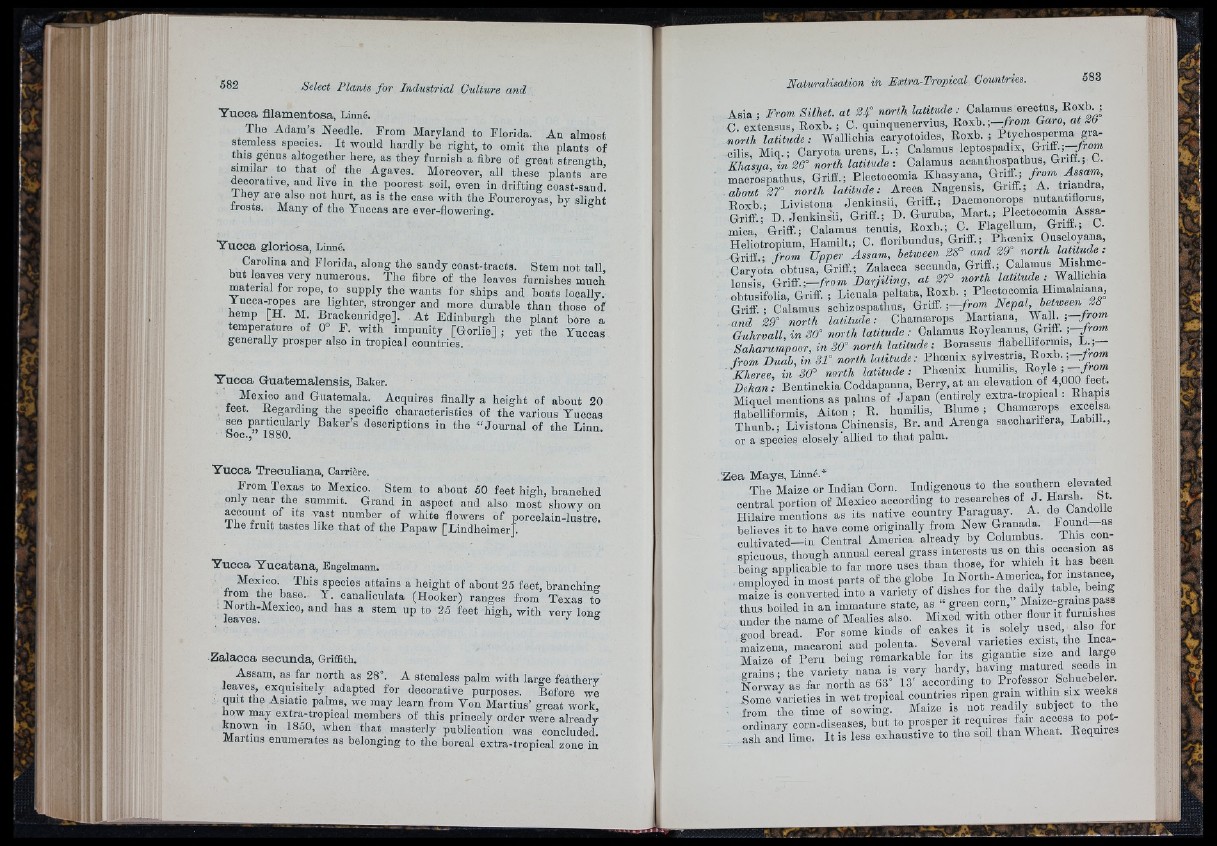
Yucca filamentosa, Linné,
The Adam’s Needle. From Maryland to Florida. An almost
stemless species. I t would hardly be right, to omit the plants of
this genus altogether here, as they furnish a fibre of great strength
similar to that of the Agaves. Moreover, all these plants aré
tocorative, and live in the poorest soil, even in drifting coast-sand
Ih e y are also not hurt, as is the case with the Fouroroyas, by slight
iroats. Many of the Yuccas are ever-flowering.
Yucca gloriosa, Linné.
Carolina and Florida, along the sandy coast-tracts. Stem not tall
but leaves very numerous. The fibre of the leaves furnishes much
material for rope, to supply the wants for ships and boats locally.
I ucca-ropes are lighter, stronger and more durable than those of
hemp [H. M Brackenridge]. A t Edinburgh the plant bore a
temperature of 0 F . with impunity [Gorlie] ; yet the Yuccas
generally prosper also in tropical countries.
Yucca Guatemalensis, Baker.
Mexico and Guatemala. Acquires finally a height of about 20
feet. Regarding the specific characteristics of the various Yuccas
see particularly Baker’s descriptions in the “ Journal of the Linn.
ooc.j 1880.
Yucca Treculiana, Carrière.
From Texas to Mexico. Stem to about 50 feet high, branched
only near the summit. Grand in aspect and also most showy on
account of its vast number of white flowers of
jorceiain-lustre.
The fruit tastes like th a t of the Papaw [Liudheimer
Yucca Yucatana, Engelmann.
Mexico This species attains a height of about 25 feet, branching
from the base. Y. canalicnlata (Hooker) ranges from Texas to
North-Mexico, and has a stem up to 25 feet high, with very lon-r
Zalacca secunda, Griffith.
Assam, as far north as 28°. A stemless palm with large feathery
leaves, exquisitely adapted for decorative purposes. Before we
quit the Asiatic palms, we may learn from Von Martins’ great work,
how may extra-tropical members of this princely order were already
known in 1850, when that masterly publication was concluded.
Martms enumerates as belonging to the boreal extra-tropical zone in
Asia ; From Silhet. at north latitude : Calamus erectas, Roxb ;
C. extensus, Roxb. ; C. quinquenervius, Roxb. '—from Garo, at 26
north latitude; Wallichia caryotoides, Roxb. ; PtychospCTma g i ^
cilis, Miq.; Caryota urens, L. ; Calamus leptospadix Griff.
Khasya, in 26° north latitude : Calamus acanthosgithus, G iiji., C.
macrospathus, Griff.; Electocomia Khasyana, Griflf; f “
about 27° north latitude: Areca Nagensis, Griff; A
Roxb.; Livistona Jenkinsii, Griff.; Daemonorops nutantiflorns.
Griff.; D .J e n k in rii, Griff.; D. Gurnba, Mart ; Plectocomia Assa-
mica Griff.; Calamus tenuis, Roxb.; C. Flagellum, Griff., C.
Heliotropium, Hamilt.; C. flo>-ib™dns, & if f .; Phoenix
Griff.; from Upper Assam, between 28° and 29 north latUude
Caryota obtusa. Griff.; Zalacca
lensis Griff.;—/Vom Darjiling, at 27° north ZatiíMJe ; Wallichia
obtusifolia. Griff. ; Licúala peltata, Roxb. ;
Griff. ; Calamus schizospathus. Griff. ;—/rom 7 n y t ,
and 29° north latitude: Chamærops Martiana, 7 “?^
Guhrvall, in S0° north latitude: Calamus Royleanus Griff. ; - / r o m
Saharumpoor, in 30° north latitude: Borassus flahelhformisT«.;--
from Duab, in 31° north latitude: Phoenix sylvestris, R o ^ . , fr om
Kheree, in 30° north latitude: Phoenix humilis,
Behan : Bentinckia Coddapanna, Berry, at an elevation of 4,000 fe to
Miquel mentions as palms of Jap an (entirely extra-tropical . Rhapis
ñabelliformis, A ito n ; R. humilis, Blume; Chamærops ex c e sa
Thunb.; Livistona Chinensis, Br. and Arenga saccharifera, Labill.,
or a species closely allied to th a t palm.
Ye a M ay s , Linné.* , * i
The Maize or Indian Corn. Indigenous to the sonthern e evated
central portion of Mexico according to researches of J . Harsta b t
Hilaire mentions as its native country Paraguay. A. de Candolle
believes it to have come originally from New Granada.
cultivated—in Central America already by Columbus. This con
spicuous, though annual cereal grass interests ns on this
being applicable to far more uses than those, for which it has been
emnfoyeci in most parts of the globe In North-America, for instance,
m a L is converted into a variety of dishes for the dally table, toing
thus boiled in an immature state, as “ green corn, Maize-pains pass
under the name of Mealies also. Mixed with other flour it
good bread. For some kinds of cakes it is solely
maizena, macaroni and polenta. Several varieties exist, the Inca-
Maize of Peru being remarkable for its gigantic size and large
grains ; the variety nana is very hardy, having matured s ^ ® “
Norway as far north as 63° 13' according to Professor Schuebeler.
' Some varieties in wet tropical countries npen gram withm weeks
from the time of sowing. Maize is not readily subject to the
ordinary corn-diseases, but to prosper it requires
ash and lime. I t is less exhaustive to the soil than Wheat. Requires